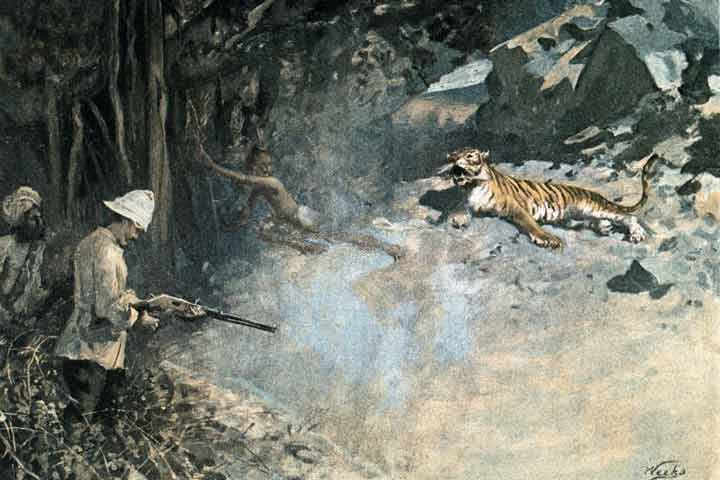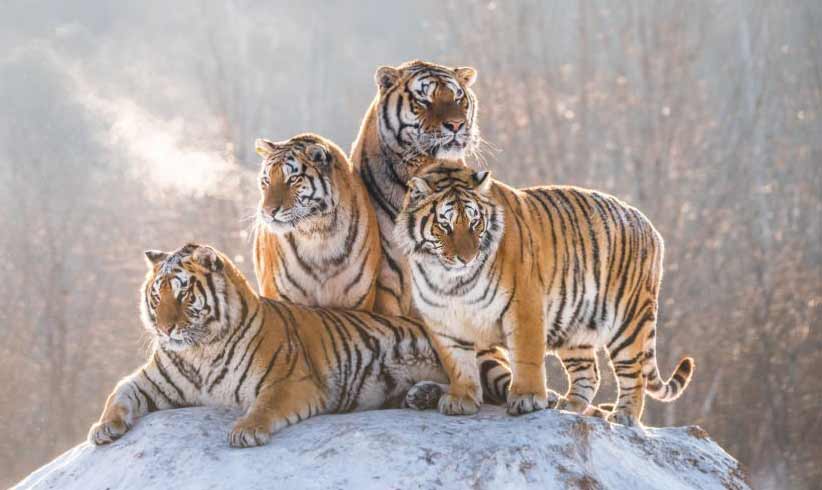The tiger, often hailed as the jungle king embodies power and grace. However, this regal creature is facing an alarming crisis.
Over the past century, tigers roaming the wild have plummeted by 95%.
With just around 5,000 left in their natural habitat, it’s crucial to understand their challenges and potential solutions.
1. Poaching
The insatiable demand for their body parts is central to the tiger’s decline, predominantly in China.

The black market thrives despite a global ban on tiger trade established in 1987. This is mainly due to weak enforcement mechanisms and a surge in demand.
Operating in the shadows, sophisticated criminal syndicates have turned tiger poaching and trade into a lucrative, multi-billion-dollar illegal industry.
2. Traditional Beliefs Fueling Demand
Traditional Chinese medicine has advocated using tiger parts, from the nose to the tail, for centuries as remedies for various ailments.

These age-old beliefs, though largely unproven, continue to drive demand. In modern times, products like tiger bone wine have emerged as symbols of luxury and status among China’s wealthy elite, adding another layer to the problem.
3. The Controversial Role of Tiger Farms
In an attempt to cater to the rising demand without hunting wild tigers, China introduced its first tiger farm in 1986. These farms, now spread across Asia, house a jaw-dropping 8,000 tigers.

While they’re marketed as conservation efforts and tourist attractions, the reality is far grimmer. Behind closed doors, these tigers are often bred rapidly and later killed for their parts.
The notorious Tiger Temple in Thailand, which faced a major scandal in 2016, is a stark example of such malpractice.
4. Habitat Loss
Our ever-expanding human population has led to rapid deforestation. The tiger’s realm shrinks as forests make way for agriculture, urban development, and infrastructure.
This loss of habitat forces tigers into closer proximity to human settlements, leading to increased human-tiger conflicts.
Moreover, as their natural prey becomes scarce due to habitat disruption, tigers are often compelled to hunt livestock, further escalating conflicts.
5. Human-Tiger Conflicts
When tigers, out of sheer desperation, venture into human territories, it often leads to tragic confrontations. In rarer cases, livestock losses and human casualties result in retaliatory killings of these magnificent beasts.

A widespread lack of awareness about the tiger’s role in maintaining ecological balance exacerbates these conflicts. Many communities, unaware of the tiger’s significance, view them as mere threats rather than vital ecosystem guardians.
Hope on the Horizon

Yet, amidst the gloom, there are glimmers of hope. The younger generation in China is increasingly skeptical of traditional beliefs and gravitates towards modern, evidence-based medicine.
This shift in mindset could drastically reduce the demand for tiger parts. Moreover, vast tracts of potential tiger habitats remain. These areas could become safe havens for thriving tiger populations with the right conservation strategies.
Conclusion
The tiger’s tale reminds us of our intricate relationship with nature. As apex predators, their well-being is a barometer for the health of our ecosystems.
By understanding their challenges and taking collective action, we can ensure that the hauntingly beautiful roar of the tiger continues to echo through our planet’s wild spaces.
FAQs
Tigers face multiple threats, including poaching, habitat loss, and human encroachment. Their population has seen a drastic decline of over 95% in the last century.
Poaching, driven by the demand for tiger parts in traditional Chinese medicine and luxury goods, is a primary reason for the decline in tiger numbers. Despite international bans, lax enforcement and growing demand have exacerbated the situation.
Tiger farms, which breed tigers for commercial purposes, have proliferated across Asia. While they might seem like a solution, they often drive up the demand for wild tiger parts, which are perceived as more potent.
Rapid deforestation and human activities have shrunk the tiger’s natural habitat. This not only reduces their territory but also their prey, forcing them to venture closer to human habitats.
When tigers, out of desperation or territorial disputes, attack livestock or even humans, they often face retaliatory killings by affected communities. This further diminishes their already dwindling numbers.
Currently, there are around 5,000 tigers remaining in the wild, making the situation critical.
Many tiger farms double as tourist attractions, offering photo opportunities with tigers. Behind the scenes, these tigers are often speed-bred and slaughtered for their parts, driving up the demand for wild tiger products.
Tigers are apex predators, playing a crucial role in maintaining ecological balance. Their survival ensures the health and diversity of the ecosystems they inhabit.




